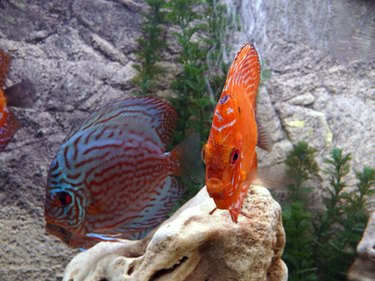Tip
Patience is the key with saltwater aquariums. Always be patient when setting them up, especially when initially adding water. It may take a lot of lowering/raising of the salt level to reach the desired level. It's also imperative that you let your tank cycle for a few weeks before attempting to add fish. Adding fish before your tank has properly cycled will be detrimental to your fish's health.
If you're apprehensive about mixing saltwater, you can typically purchase pre-mixed water that is properly measured and mixed from pet shops like Petco.

Saltwater aquariums are a beautiful addition to any home; marine fish often have a beauty that freshwater fish often cannot replicate. Setting up a saltwater aquarium can be a difficult task that requires very careful preparation. A 55-gallon tank is one of the more popular sizes when it comes to aquariums, as it allows for a lot of swimming space and serves as an excellent display tank, and is readily available at most pet shops. Setting up a 55-gallon saltwater fish tank requires several materials and many steps, not to mention a lot of patience, so proceed knowing that it won't be easy, but the experience can be very rewarding.
Initial Setup
Video of the Day
Step 1
Place your empty tank in an area of indirect sunlight. Direct exposure to sunlight will promote the growth of algae, which is not only unattractive, but could also be detrimental to your fish.
Video of the Day
Step 2
Layer the bottom of the tank with about an inch of substrate, being either gravel, sand or crushed coral. Crushed coral is often preferred for saltwater tanks, as it tends to raise the water's pH level, which is better for marine fish.
Step 3
Place any decorations you'd like to include in your tank during this time.
Step 4
Hang the filter on the back of the tank according to your specific filter model's instruction manual. Note that you do not have to use a hanging filter, it is just one of the most common and easiest to install. Saltwater aquariums need much better filtration than freshwater aquariums, hence the usage of a 110-gallon filter instead of a 55-gallon filter. Also make sure that the filter you use has a medium for beneficial bacteria to grow, like a bio-wheel. Consult your local pet shop employee when deciding on a proper filter.
Step 5
Attach a protein skimmer, which hangs on the tank similar to the filter. Protein skimmers are only required if you're planning on putting live coral into your aquarium.
Adding the Water
Step 1
Fill the tank with fresh water until it is about an inch from the top and plug the filter into a power outlet so that the water begins cycling.
Step 2
Add the Instant Ocean salt. Consult the packaging for exactly how much to add. Typically, each large box of Instant Ocean is enough salt for 25 gallons of water, so consider using two whole large boxes as well as a small box (which is appropriate for about five gallons).
Step 3
Let the filter mix the water for about two hours, then use the hydrometer to test the salinity level. Simply dip the hydrometer into the water, letting it fill up, then the floating needle in the device will point to the specific gravity (salinity level). You're goal is around 1.020 parts per trillion. Adjust the level accordingly until you achieve the appropriate results; add salt to raise the level and dilute it with freshwater to lower the level.
Step 4
Test the pH level using a pH test kit; a normal level should be around 8.3. Consult your specific kit's instruction manual for directions particular to that manufacturer. Adjust your pH level accordingly using pH buffers.
Step 5
Place a fluorescent light strip, which may be incorporated into the top of the tank, over the aquarium. Now let your saltwater aquarium cycle for at least three to four weeks. Once that time is up, test the salinity and pH again. If they're appropriate, you're free to add fish.